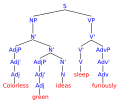Language complexity is a topic in linguistics which can be divided into several sub-topics such as phonological, morphological, syntactic, and semantic...
14 KB (1,480 words) - 18:33, 2 April 2025
Kolmogorov complexity of an object, such as a piece of text, is the length of a shortest computer program (in a predetermined programming language) that produces...
58 KB (7,565 words) - 20:43, 12 April 2025
time complexity (Greenlaw and Hoover 1998: 226), while inductive Turing machines can decrease even the complexity class of a function, language or set...
38 KB (4,498 words) - 06:11, 13 March 2025
In computational complexity theory, a complexity class is a set of computational problems "of related resource-based complexity". The two most commonly...
75 KB (10,382 words) - 21:14, 20 April 2025
circuits that compute them. A related notion is the circuit complexity of a recursive language that is decided by a uniform family of circuits C 1 , C 2...
21 KB (2,571 words) - 09:38, 2 April 2025
occasionally challenged. (See also language complexity.) Phylogenetic or typological comparisons of creole languages have led to divergent conclusions...
71 KB (8,000 words) - 16:41, 4 May 2025
of complexity classes in computational complexity theory. For other computational and complexity subjects, see list of computability and complexity topics...
8 KB (176 words) - 07:24, 19 June 2024
In theoretical computer science and mathematics, computational complexity theory focuses on classifying computational problems according to their resource...
50 KB (6,704 words) - 15:08, 29 April 2025
in computer science In computational complexity theory, NL (Nondeterministic Logarithmic-space) is the complexity class containing decision problems that...
10 KB (1,290 words) - 01:33, 29 September 2024
natural languages, in which the words of the language represent concepts that are associated with meanings or semantics. In computational complexity theory...
27 KB (3,163 words) - 09:25, 2 May 2025
In computability theory and computational complexity theory, a reduction is an algorithm for transforming one problem into another problem. A sufficiently...
11 KB (1,658 words) - 21:46, 20 April 2025
language Language learning aptitude Language acquisition Language complexity List of common misconceptions about language learning List of language acquisition...
64 KB (7,305 words) - 11:36, 7 April 2025
of complexity. This type of language is generally called a creole language. An example of such mixed languages is Tok Pisin, the official language of...
139 KB (16,424 words) - 08:32, 4 April 2025
Övdalian (redirect from Elfdalian language)
assumption of complexity invariance: the case of Elfdalian and Swedish". In Sampson, G., Gil, D., & Trudgill, P. (ed.). Language complexity as an evolving...
39 KB (3,433 words) - 08:02, 5 May 2025
express the languages in them. For example, PH, the union of all complexity classes in the polynomial hierarchy, is precisely the class of languages expressible...
18 KB (2,543 words) - 00:29, 14 November 2024
sermocinalis (science of language). The result of their studies was the elaboration of linguistic-philosophical notions whose complexity and subtlety has only...
67 KB (8,614 words) - 05:40, 5 May 2025
In computational complexity theory, L (also known as LSPACE, LOGSPACE or DLOGSPACE) is the complexity class containing decision problems that can be solved...
8 KB (909 words) - 05:48, 26 February 2025
problems in computer science In computational complexity theory, NP (nondeterministic polynomial time) is a complexity class used to classify decision problems...
21 KB (2,784 words) - 18:11, 6 May 2025
second language acquisition, 631-678. P. J. Robinson (Ed.), Second language task complexity: Researching the cognition hypothesis of language learning...
30 KB (3,843 words) - 08:26, 23 April 2025
high-level, general-purpose, memory-safe, object-oriented programming language. It is intended to let programmers write once, run anywhere (WORA), meaning...
73 KB (6,608 words) - 19:14, 4 May 2025
In complexity theory, PP, or PPT is the class of decision problems solvable by a probabilistic Turing machine in polynomial time, with an error probability...
16 KB (2,345 words) - 23:47, 3 April 2025
In computational complexity theory, P, also known as PTIME or DTIME(nO(1)), is a fundamental complexity class. It contains all decision problems that can...
15 KB (1,923 words) - 10:06, 14 January 2025
the time complexity is the computational complexity that describes the amount of computer time it takes to run an algorithm. Time complexity is commonly...
41 KB (5,003 words) - 04:16, 18 April 2025
definitions for some complexity classes which can alternatively be characterised in terms of nondeterministic Turing machines. A language L {\displaystyle...
5 KB (671 words) - 01:24, 20 February 2025
In computer science, parameterized complexity is a branch of computational complexity theory that focuses on classifying computational problems according...
18 KB (2,684 words) - 06:53, 23 March 2025
In computational complexity theory, SL (Symmetric Logspace or Sym-L) is the complexity class of problems log-space reducible to USTCON (undirected s-t...
14 KB (1,793 words) - 15:43, 24 May 2024
computational complexity theory of computer science, the structural complexity theory or simply structural complexity is the study of complexity classes, rather...
6 KB (672 words) - 08:43, 22 October 2023
consecutive symbols) of that string. More generally, the complexity function of a formal language (a set of finite strings) counts the number of distinct...
10 KB (1,313 words) - 03:08, 26 March 2025
The space complexity of an algorithm or a data structure is the amount of memory space required to solve an instance of the computational problem as a...
7 KB (1,004 words) - 18:51, 17 January 2025
Cyclomatic complexity is a software metric used to indicate the complexity of a program. It is a quantitative measure of the number of linearly independent...
23 KB (2,912 words) - 22:16, 10 March 2025












